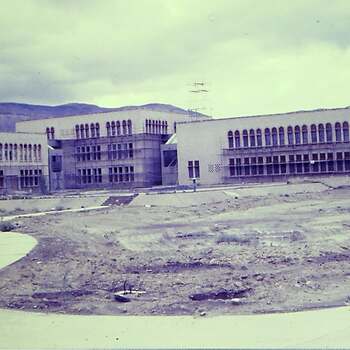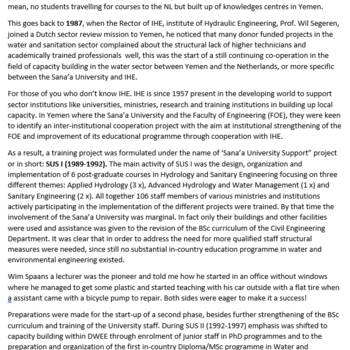Cooperation IHE/ Capacity building start 1989
One of the first joint projects was the transfer of knowledge in what the Dutch had built over the years worldwide and the hundred years of local experiences in harsh conditions. What does this mean: no students travelling for courses to the NL but built up of knowledge centres in Yemen.
This goes back to 1987, when the Rector of the Institute of Hydraulic Engineering (IHE), Prof. Wil Segeren, joined a Dutch sector review mission to Yemen, he noticed that many donor-funded projects in the water and sanitation sector complained about the structural lack of higher technicians and academically trained professionals well, this was the start of a still continuing co-operation in the field of capacity building in the water sector between Yemen and the Netherlands, or more specifically between the Sana’a University and IHE.
For those of you who don’t know the Institute of Hydraulic Engineering (IHE). IHE is since 1957 present in the developing world to support sector institutions like universities, ministries, research and training institutions in building up local capacity. In Yemen where the Sana’a University and the Faculty of Engineering (FOE), they were keen to identify an inter-institutional cooperation project with the aim at institutional strengthening of the FOE and improvement of its educational programme through cooperation with IHE.
As a result, a training project was formulated under the name of Sana’a University Support project or in short: SUS I (1989-1992). The main activity of SUS I was the design, organization and implementation of 6 post-graduate courses in Hydrology and Sanitary Engineering focusing on three different themes: Applied Hydrology (3 x), Advanced Hydrology and Water Management (1 x) and Sanitary Engineering (2 x). All together 106 staff members of various ministries and institutions actively participating in the implementation of the different projects were trained. By that time the involvement of the Sana’a University was marginal. In fact only their buildings and other facilities were used and assistance was given to the revision of the BSc curriculum of the Civil Engineering Department. It was clear that in order to address the need for more qualified staff structural measures were needed since still no substantial in-country education programme in water and environmental engineering existed.
Wim Spaans a lecturer was the pioneer and told me how he started in an office without windows where he managed to get some plastic and started teaching with his car outside with a flat tire when an assistant came with a bicycle pump to repair. Both sides were eager to make it a success!
Preparations were made for the start-up of a second phase, besides further strengthening of the BSc curriculum and training of the University staff. During SUS II (1992-1997) emphasis was shifted to capacity building within DWEE through enrolment of junior staff in PhD programmes and to the preparation and organization of the first in-country Diploma/MSc programme in Water and Environmental Engineering. One of the milestones was the start of the first 2-year Diploma/MSc course in October 1994. A group of 12 participants finalised the Diploma course and 5 out of them continued for the second year MSc follow-up. At the same time a start was made with a framework for applied research.
Sources - Read more
document Cooperation IHE Yemen

